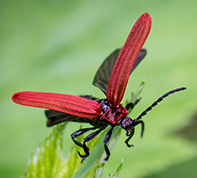Coleoptera collection

(Photo: Aslak Kappel Hansen)
Curator
Collection manager
Anders Illum, Jan Pedersen & Sree Gayathree Selvantharan
About the collection
Coleoptera forms the largest insect subcollection of the Natural History Museum of Denmark. Its main body is the section of pinned specimens spanning the entire order from all regions of the world.
The pinned beetle collection is divided in four sections: A) Global collection particularly strong for the Palearctic and Afrotropical regions; B) Danish collection which is a detailed archive of the local fauna across the Danish archipelago; C) Beetles from Greenland, Iceland and the Faroe Islands; and D) the Coleoptera type material.
The type collection is dominated by the types of C.R.W. Wiedemann, but includes types . About 25 % of the type collection is formed by numerous other authors.
Taxonomically, the global Coleoptera collection is particularly notable for Carabidae and Hydrophilidae. The Staphylinidae section is the most actively curated and fast growing.
Additionally it comprises non-quantified samples of beetles, bulk and (sub)sorted, as well as a collection of beetle larvae (mostly Danish fauna), all kept in 70% alcohol. DNA-grade material (few hundred lots and individual species, mostly Staphylinidae, stored in 96% alc., -20°C) is becoming a growing part of the collection.

(Photo: Line Kræmer)
Coleoptera collection in numbers
- Estimated total number of specimens: More than 4,000,000 specimens
- Pinned specimens: 3,000,000 specimens
- Types digitized: 2,100 specimens for 1,067 species
- Digitally available specimens: Approx. 3,400
- Percentage digitized: 0.07%
Strengths
- Medium-sized, well-curated and easy to navigate collection, which can form a base for any project in beetle systematics with global coverage.
- Dynamic Staphylinidae secton of the collection, driven by active research program (Solodovnikov lab, BIG4).
- Danish faunistic collection including excellent synoptic display of every beetle species recorded for Denmark.
History
The current beetle collection grew gradually. Early specimens come from the renowned entomologists C.R.W. Wiedemann, J.M.C. Schiødte and others.
Among later significant contributions the most notable are accessions of private collections of E. Suenson (mostly Carabidae from China, North America and Japan) and V. Hansen (Danish Coleoptera).
 During the late 20th century major contribution to its curation and growth was made by M. Hansen (late world class expert in Hydrophilidae) and O.O. Martin (now retired former assistant curator). Among latest accessions most notable are donated collections of late V. Mahler (various Coleoptera, big Danish collection) and O. Mehl (Cerambycidae, especially from the Oriental region).
During the late 20th century major contribution to its curation and growth was made by M. Hansen (late world class expert in Hydrophilidae) and O.O. Martin (now retired former assistant curator). Among latest accessions most notable are donated collections of late V. Mahler (various Coleoptera, big Danish collection) and O. Mehl (Cerambycidae, especially from the Oriental region).
In addition to donations, the collection is growing due to regular expeditions of the current curatorial staff and associated students.
Fabricius beetle collection
The entire Fabricius beetle collection was relocated to the Zoological Museum in Kiel in 2017.
For several decades the Zoological Museum (ZMUC, now part of the NHMD - Natural History Museum of Denmark) hosted the beetle collection of the great Danish entomologist I.C. Fabricius (1745-1808), one of the founders of systematic entomology.
As a legacy of Fabricius’ dual employment at Copenhagen and in Kiel (then a Danish city, now Germany), this globally important collection consisted of two parts deposited at Copenhagen and in Kiel, respectively. After World War II, the Kiel part of the collection was moved to Copenhagen as a long-term loan to be curated by the NHMD (then ZMUC) staff.
In 2015 the Kiel Museum requested their part of the Fabricius collection to be returned. Since the majority of Fabrician species has their type series split between the Copenhagen and Kiel parts of the collection, and the latter part is significantly bigger than the former, a decision was made to relocate.
